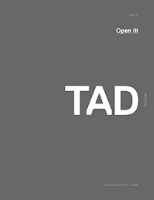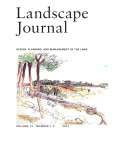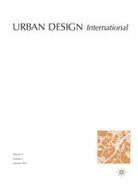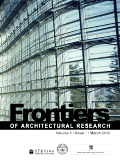
Architecture_MPS
Scope & Guideline
Exploring the Nexus of Architecture and Society
Introduction
Aims and Scopes
- Participatory and Inclusive Design:
The journal focuses on community engagement and participatory design processes, examining how architecture can foster inclusivity and address social inequalities. - Interdisciplinary Research:
It encourages interdisciplinary approaches, integrating perspectives from sociology, cultural studies, and environmental science to enrich architectural discourse. - Urban Resilience and Sustainability:
A core aim is to investigate urban resilience and sustainability, exploring how architecture can respond to challenges such as climate change, urbanization, and social stratification. - Historical and Cultural Contextualization:
The journal emphasizes the importance of understanding historical and cultural contexts in architectural practices, promoting critical reflections on past and present design strategies. - Health and Well-being in Architecture:
There is a consistent focus on the relationship between architectural design and the health and well-being of communities, addressing how built environments impact mental and physical health.
Trending and Emerging
- Reparative and Restorative Practices:
There is an increasing focus on design reparations and restorative practices, particularly in addressing historical injustices and urban neglect, as seen in discussions surrounding policies in Harlem and community engagement. - Eco-Gentrification and Environmental Justice:
The journal is increasingly addressing eco-gentrification and its impacts on communities, emphasizing the need for sustainable practices that prioritize social equity alongside environmental concerns. - Decolonization in Architecture:
Emerging discussions on decolonizing design practices and curricula demonstrate a significant trend towards acknowledging and addressing colonial histories and their impacts on contemporary architectural practices. - Participatory Urbanism:
The trend of participatory urbanism is growing, with a focus on community-led initiatives and tactical urbanism strategies that empower local populations to shape their environments. - Health-Centric Design Approaches:
The relevance of health-centric design approaches is gaining traction, particularly in light of recent global health crises, emphasizing the need for built environments that promote well-being and resilience.
Declining or Waning
- Traditional Architectural Aesthetics:
There appears to be a declining interest in traditional architectural aesthetics, as newer publications focus more on socio-political implications and participatory approaches rather than purely aesthetic considerations. - Historical Architectural Styles:
Themes centered around historical architectural styles and their preservation are less frequently addressed, indicating a shift towards more contemporary and innovative design practices. - Urban Planning as a Static Discipline:
The notion of urban planning as a static, top-down discipline has waned, with a noticeable decrease in papers discussing conventional urban planning frameworks without considering community input or dynamic processes.
Similar Journals

Archnet-IJAR International Journal of Architectural Research
Advancing architectural innovation through interdisciplinary dialogue.Archnet-IJAR International Journal of Architectural Research serves as an esteemed platform within the field of architecture and urban studies, published by Emerald Group Publishing Ltd. With an impressive impact reflected through its Q1 category rankings in both Architecture and Urban Studies, this journal highlights cutting-edge research and innovative practices spanning diverse architectural disciplines. The journal focuses on facilitating interdisciplinary dialogues, making it a vital resource for researchers, students, and professionals keen on advancing their understanding of architectural theories and urban design. With its commitment to quality, evidenced by high scores in various Scopus rankings, including a rank of 9th in Visual Arts and Performing Arts, Archnet-IJAR aims to publish work that not only challenges conventional boundaries but also enriches practical applications in the built environment. Its open-access model ensures wider dissemination of knowledge, fostering collaboration and growth within the international architectural community.

ARCHITECTURAL RECORD
Illuminating Architectural Insights and PracticesARCHITECTURAL RECORD, published by McGraw Hill Inc, stands as a vital resource in the field of architecture and design, offering insightful perspectives and critical analyses that cater to architects, designers, and academia alike. With an ISSN of 0003-858X, this prestigious journal has been a cornerstone for the architectural community, providing a blend of contemporary practices and theoretical frameworks since its inception. Although it is not currently available through Open Access, its rich content contributes to the ongoing dialogue in both the Visual Arts and Performing Arts, as well as Engineering and Architecture disciplines. The journal's historical impact can be seen through its wide readership and influence in shaping architectural discourse, making it a highly regarded publication for professionals and students in the field. As a beacon of innovative practices, ARCHITECTURAL RECORD continues to inspire and educate, even despite its coverage discontinuation in Scopus since 2018.

Architecture and Culture
Unveiling the Stories Behind Architectural SpacesArchitecture and Culture is an esteemed journal published by Routledge Journals, Taylor & Francis Ltd, focusing on the intersection of architecture, cultural studies, urbanism, and the visual and performing arts. Since its inception, this journal has become a vital platform for researchers, professionals, and students to explore the multifaceted relationship between architecture and cultural identity within contemporary contexts. With an ISSN of 2050-7828 and an E-ISSN of 2050-7836, the journal reaches a global audience from its base in the United Kingdom. Featuring a commendable Q2 ranking in Visual Arts and Performing Arts and a consistent presence in multiple relevant quartiles, including Q3 in both Architecture and Cultural Studies, it is well-regarded for its scholarly impact. The journal offers a unique opportunity for interdisciplinary dialogue, fostering innovative research that examines how built environments shape and are shaped by cultural narratives. This commitment to advancing knowledge in these fields is reflected in its ongoing publication from 2014 to 2024, making it a pivotal resource for those at the forefront of the discourse on architecture and culture.

Technology-Architecture + Design
Transforming Ideas into Architectural RealitiesTechnology-Architecture + Design is a pioneering academic journal published by Taylor & Francis Ltd, dedicated to exploring the intersection of technology within architectural and design practices. With an impactful presence in the field since its inception in 2017, the journal has quickly ascended in academic rankings, achieving a Q2 categorization in Architecture and a notable Q1 ranking in Visual Arts and Performing Arts, underscoring its significance in these dynamic areas of study. The journal aims to provide an open platform for innovative research that addresses contemporary challenges in architecture and urban planning, utilizing technological advancements as a central theme. As a vital resource for scholars, practitioners, and students alike, Technology-Architecture + Design publishes high-quality, peer-reviewed articles that contribute to the discourse surrounding sustainable design, digital fabrication, and smart urbanism, making it an essential read for those passionate about the future of built environments.

Landscape Journal
Connecting Nature and Scholarship with Every IssueWelcome to the Landscape Journal, a prominent publication in the field of Nature and Landscape Conservation, proudly brought to you by University of Wisconsin Press. Since its inception, this journal has strived to underpin the critical interplay between environmental science and landscape architecture, providing a platform for innovative research and comprehensive insights. With an ISSN of 0277-2426 and an E-ISSN of 1553-2704, the Landscape Journal is indexed in leading academic databases and recognized with a 2023 Scopus Rank of #167, placing it in the 21st percentile among its peers. The journal operates from the heart of the United States, featuring converged years from 2009 to 2019 and again from 2021 to 2024, making it a reliable resource for ongoing dialogue in landscape studies. Although it currently does not offer open access, the Landscape Journal remains an essential resource for researchers, professionals, and students dedicated to understanding and enhancing our natural environments. As a Q3 category journal, it invites contributions that push the boundaries of landscape research while fostering environmental stewardship.

METU Journal of the Faculty of Architecture
Shaping the future of architectural studies with impactful insights.METU Journal of the Faculty of Architecture is a reputable academic publication dedicated to advancing research and discourse in the field of architecture. Published by MIDDLE EAST TECHNICAL UNIVERSITY in Turkey, this journal serves as a vital platform for scholars and practitioners, addressing both theoretical and practical topics relevant to contemporary architectural studies. With an impact factor that positions it in the Q3 category for architecture as of 2023, and a Scopus rank of #133 out of 189 in Engineering Architecture, the METU Journal is an influential resource for innovative ideas and studies. Encompassing a wide range of scholarly articles, it fosters academic collaboration between researchers and professionals, making it essential reading for anyone passionate about the evolution of architecture. Though not open access, it provides crucial insights and rigorous research from 2008 up until 2024, contributing significantly to the global discourse on architectural practices and theories.

i2 Investigacion e Innovacion en Arquitectura y Territorio
Exploring innovative pathways in urban planning and environmental design.i2 Investigacion e Innovacion en Arquitectura y Territorio is a leading open-access journal published by the University of Alicante, dedicated to advancing research and innovation in the fields of architecture and territorial development. Since its inception in 2013, this journal has aimed to provide a robust platform for scholarly discourse, promoting interdisciplinary approaches that connect academic insights with practical applications in urban planning and environmental design. With its commitment to accessibility, the journal ensures that cutting-edge findings and case studies are readily available to researchers, professionals, and students alike, fostering collaboration and informed decision-making. As the landscape of architecture and geography continues to evolve, the i2 journal stands out as a crucial resource for enhancing knowledge and cultivating innovative practices in these dynamic fields.

Manzar-The Scientific Journal of Landscape
Cultivating Insights into Our Built and Natural WorldsWelcome to Manzar - The Scientific Journal of Landscape, a premier academic outlet focusing on the interdisciplinary exploration of landscape studies, offering insights into art, architecture, and urbanism. Published by the NAZAR RESEARCH CENTER, this journal has been an Open Access platform since 2009, fostering free exchange of knowledge and supporting the dissemination of research in landscape architecture and urban studies. Renowned for its commitment to advancing scholarly dialogue, Manzar provides an essential resource for researchers, professionals, and students captivated by the complexities and aesthetics of landscapes. With an ISSN of 2008-7446 and E-ISSN of 2008-2169, the journal presents a diverse range of articles that investigate the interactions between natural and built environments. Located in Tehran, Iran, Manzar not only enhances local discourse but also contributes globally to the field of landscape studies.

Urban Design International
Innovative research for dynamic urban planning.Urban Design International, published by Palgrave Macmillan Ltd, stands as a pivotal journal in the fields of Urban Studies and Geography, Planning and Development. Since its inception in 1996, this UK-based journal has become a leading platform for innovative research and discourse, maintaining a Q1 classification in Urban Studies and a Q2 ranking in Geography, Planning and Development as of 2023. With an impressive Scopus ranking of 48 out of 279 in Urban Studies, the journal's contributions are recognized globally, evidenced by its 82nd percentile standing. While currently not an open-access publication, it provides a vital resource for academics, urban planners, and policymakers engaging with the complexities of urban environments. With an aim to foster interdisciplinary collaboration and critical analysis of urban design practices, Urban Design International is committed to pushing the boundaries of knowledge in sustainable urban development and design.

Frontiers of Architectural Research
Shaping the Future of Architecture Through Open ScholarshipFrontiers of Architectural Research, published by KEAI PUBLISHING LTD, stands at the forefront of interdisciplinary scholarship, addressing contemporary challenges in the fields of architecture, urban studies, building and construction, and archaeology. Since its establishment in 2012, this open-access journal has rapidly gained recognition, achieving prestigious rankings in the 2023 category quartiles, including Q1 placements in both Architecture and Archaeology. With an impressive Scopus rank of #5 out of 354 in Archaeology and #10 out of 189 in Engineering - Architecture, it demonstrates its significant influence and contribution to advancing architectural research. Frontiers of Architectural Research embraces a broad scope that fosters innovative discourse and practical solutions, catering to a diverse audience of researchers, professionals, and students keen on exploring the intersection of culture, environment, and technology. By ensuring immediate access to research findings, the journal not only enhances the visibility of scholarly work but also encourages collaborative dialogues that shape the future of architectural practice.